French actress Marie Déa (1912-1992) became famous through two classics of the French cinema, Marcel Carné 's Les Visiteurs du Soir/The Devil's Envoys (1942) and Jean Cocteau's Orphée/Orpheus (1950).
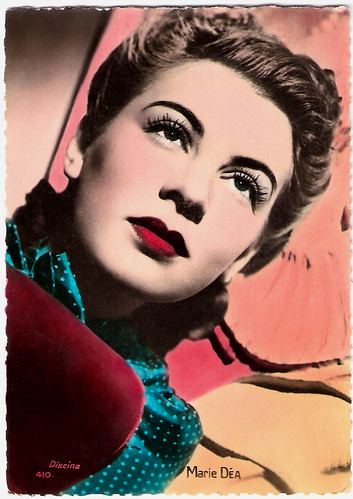
French postcard, no. 410. Photo: Discina.
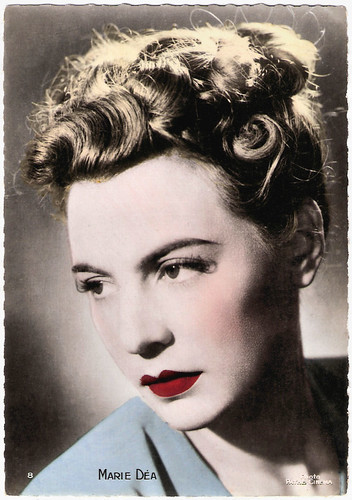
French postcard by Editions P.I., Paris, no. 8. Photo: Pathé Cinema.
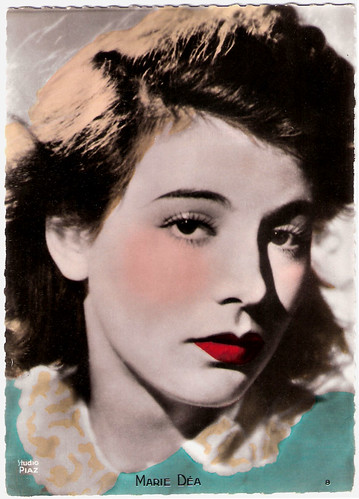
French postcard by Editions P.I., Paris, no. 8. Photo: Studio Paz.
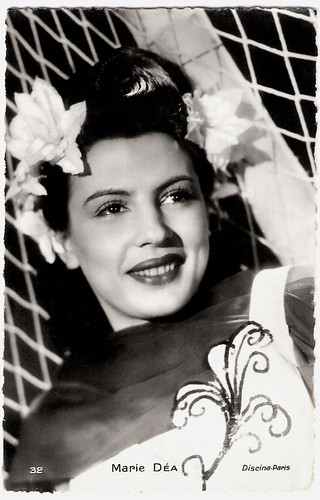
French postcard by Edit. Chantal, Rueil, no. 32. Photo: Discina, Paris.
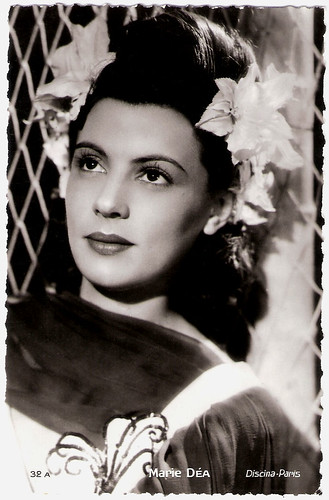
French postcard by Edit. Chantal, Rueil, no. 32 A. Photo: Discina, Paris.
Marie Déa was born as Odette Alice Marie Deupès in Nanterre, France in 1912. After completing a law studies she followed a drama course and began her career with small roles. In 1939 she appeared in the film Nord-Atlantique/North Atlantic (Maurice Cloche, 1939), which introduced her to the public.
In her next film Pièges/Personal Column (Robert Siodmak, 1939) she starred opposite Maurice Chevalier. In this excellent thriller, Déa plays an amateur detective, whose friend was a victim of a maniac who finds his prey through small ads. James Travers at French Films: “Marie Déa is impressive as the no-nonsense and gutsy Adrienne, a refreshing contrast to the feeble, two-dimensional screen heroines of the time. In many ways, Pièges is the template for the crime thriller which would become one of the most popular genres in French cinema in subsequent decades.”
Next, she was the leading lady in Premier bal/First Ball (Christian-Jaque, 1941) opposite François Périer, Histoire de rire/Foolish Husbands (Marcel L’Herbier, 1941) with Fernand Gravey, and Le journal tombe à cinq heures/The newspaper falls at five o'clock (Georges Lacombe, 1942) starring Pierre Fresnay.
In 1942 she appeared in Les visiteurs du soir/The Devil's Envoys (Marcel Carné, 1942), one of the timeless masterpieces which came out of the fruitful collaboration between director Marcel Carné and screenwriter Jacques Prévert. The film was hailed as a major cinematographic achievement upon its release in 1942 and was one of the most popular films made under the Nazi Occupation.
In this tale set in the Middle Ages, Marie Déa plays a baron’s daughter with a pure heart who is lured from her fiancé by a handsome minstrel (Alain Cuny), who is sent by the devil. The minstrel is caught in his own trap and falls in love, and the couple then has to fight the devil. At IMDb, DB Dumonteil writes: “During the German occupation, it was an alibi: the Devil was meant to represent Hitler and the two lovers the Resistance. But for the people at the time, their hints at French plight were so disguised - or else, it would have been banned by the censorship -, they only saw the escapist movie which they did need.”
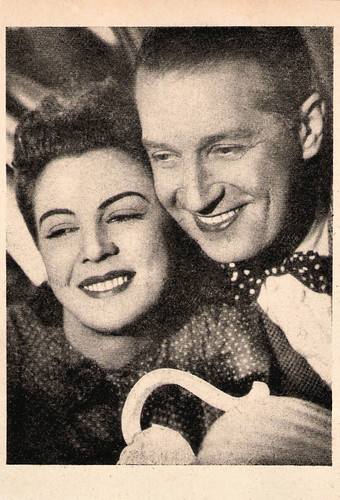
German postcard. Photo: IFA. Publicity still for Pièges/Personal Column (Robert Siodmak, 1939) with Maurice Chevalier.
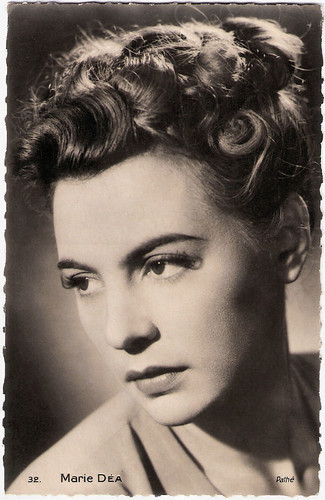
French postcard by Editions E.C., Paris, no. 32. Photo: Pathé.

French postcard by Ed. ChantaI, Rueil, Paris, no. 57. Photo: C.P.L.F.
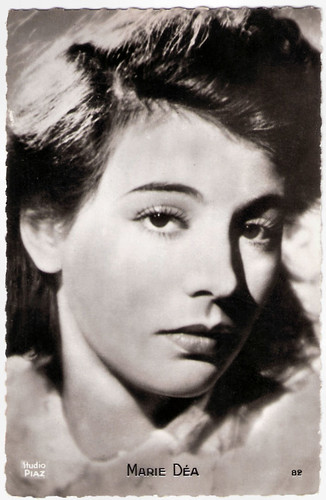
French postcard by Editions P.I., Paris, no. 82. Photo: Studio Paz.
After the war, Marie Déa continued to play leading roles in French films, but most of them were quite mediocre. Interesting is the remake La maternelle (Henri Diamant-Berger, 1949), in which Déa played a headmistress of a kindergarten in poverty-stricken Ménilmontant. In Spain, she appeared opposite Fernando Rey in Aventuras de Juan Lucas/Adventures of Juan Lucas (Rafael Gil, 1949).
Then she appeared in another classic of the French cinema, Jean Cocteau’s Orphée/Orpheus (1950), an update of the Greek myth of Orpheus and Eurydice in post-war France. Déa played Eurydice to Jean Marais’ modern Orpheus.
RobertF97 at IMDb: "Writer-director Jean Cocteau turns the everyday world into a magical realm. Mirrors turn to pools which are portals to other worlds, and car radios pick up coded messages from Death's World. In less talented hands than Cocteau's, the delicate fantasy could have easily become ridiculous but he handles it with brilliance and the film works perfectly. Here Cocteau creates a truly poetic film. The story is magical and entertaining and the film is filled with wondrously surreal images (particularly striking is the frequent use of filming an action performed backwards, and then reversing it which creates a very strange impression).”
During the 1950s, Déa only played incidentally supporting parts in films, such as in the comedy La jument verte/The Green Mare (Claude Autant-Lara, 1959) starring Bourvil. During the following decade, she was seen with Fernandel in L'assassin est dans l'annuaire/Assassin in the Phonebook (Léo Joannon, 1962), and in the crime drama Le glaive et la balance/The Sword and the Balance (André Cayatte, 1963) starring Anthony Perkins. During the 1960s and 1970s, she regularly worked for TV.
Among her later film appearances are Mariage/Marriage (Claude Lelouch, 1974) with Bulle Ogier, L'homme pressé/Man in a Hurry (Edouard Molinaro, 1977) starring Alain Delon, and Subversion (Stanislav Stanojevic, 1979). In 1992, Marie Déa died accidentally after a fire in Paris. She was 79.

French postcard by Editions P.I., Paris, no. 82. Photo: Carlet.
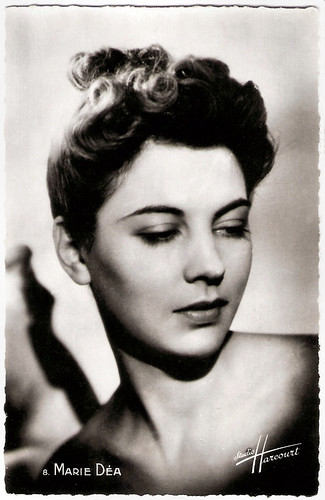
French postcard by SERP, Paris, no. 8. Photo: Studio Harcourt.

French postcard by Editions P.I., Paris, no. 82. Photo: Ch. Vandamme, Les Mirages.
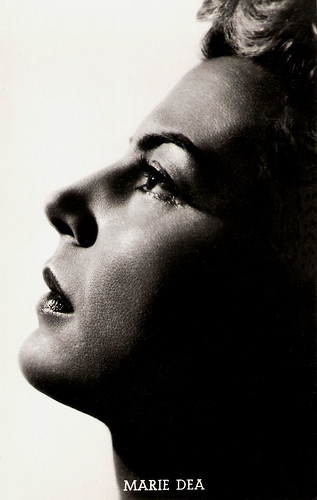
French postcard. Photo: MGM.
Sources: James Travers (French Films), DB Dumonteil (IMDb), Robert F87 (IMDb), Wikipedia (French) and IMDb.
This post was last updated on 6 December 2023.

French postcard, no. 410. Photo: Discina.

French postcard by Editions P.I., Paris, no. 8. Photo: Pathé Cinema.

French postcard by Editions P.I., Paris, no. 8. Photo: Studio Paz.

French postcard by Edit. Chantal, Rueil, no. 32. Photo: Discina, Paris.

French postcard by Edit. Chantal, Rueil, no. 32 A. Photo: Discina, Paris.
No-nonsense and gutsy
Marie Déa was born as Odette Alice Marie Deupès in Nanterre, France in 1912. After completing a law studies she followed a drama course and began her career with small roles. In 1939 she appeared in the film Nord-Atlantique/North Atlantic (Maurice Cloche, 1939), which introduced her to the public.
In her next film Pièges/Personal Column (Robert Siodmak, 1939) she starred opposite Maurice Chevalier. In this excellent thriller, Déa plays an amateur detective, whose friend was a victim of a maniac who finds his prey through small ads. James Travers at French Films: “Marie Déa is impressive as the no-nonsense and gutsy Adrienne, a refreshing contrast to the feeble, two-dimensional screen heroines of the time. In many ways, Pièges is the template for the crime thriller which would become one of the most popular genres in French cinema in subsequent decades.”
Next, she was the leading lady in Premier bal/First Ball (Christian-Jaque, 1941) opposite François Périer, Histoire de rire/Foolish Husbands (Marcel L’Herbier, 1941) with Fernand Gravey, and Le journal tombe à cinq heures/The newspaper falls at five o'clock (Georges Lacombe, 1942) starring Pierre Fresnay.
In 1942 she appeared in Les visiteurs du soir/The Devil's Envoys (Marcel Carné, 1942), one of the timeless masterpieces which came out of the fruitful collaboration between director Marcel Carné and screenwriter Jacques Prévert. The film was hailed as a major cinematographic achievement upon its release in 1942 and was one of the most popular films made under the Nazi Occupation.
In this tale set in the Middle Ages, Marie Déa plays a baron’s daughter with a pure heart who is lured from her fiancé by a handsome minstrel (Alain Cuny), who is sent by the devil. The minstrel is caught in his own trap and falls in love, and the couple then has to fight the devil. At IMDb, DB Dumonteil writes: “During the German occupation, it was an alibi: the Devil was meant to represent Hitler and the two lovers the Resistance. But for the people at the time, their hints at French plight were so disguised - or else, it would have been banned by the censorship -, they only saw the escapist movie which they did need.”

German postcard. Photo: IFA. Publicity still for Pièges/Personal Column (Robert Siodmak, 1939) with Maurice Chevalier.

French postcard by Editions E.C., Paris, no. 32. Photo: Pathé.

French postcard by Ed. ChantaI, Rueil, Paris, no. 57. Photo: C.P.L.F.

French postcard by Editions P.I., Paris, no. 82. Photo: Studio Paz.
Magical and entertaining
After the war, Marie Déa continued to play leading roles in French films, but most of them were quite mediocre. Interesting is the remake La maternelle (Henri Diamant-Berger, 1949), in which Déa played a headmistress of a kindergarten in poverty-stricken Ménilmontant. In Spain, she appeared opposite Fernando Rey in Aventuras de Juan Lucas/Adventures of Juan Lucas (Rafael Gil, 1949).
Then she appeared in another classic of the French cinema, Jean Cocteau’s Orphée/Orpheus (1950), an update of the Greek myth of Orpheus and Eurydice in post-war France. Déa played Eurydice to Jean Marais’ modern Orpheus.
RobertF97 at IMDb: "Writer-director Jean Cocteau turns the everyday world into a magical realm. Mirrors turn to pools which are portals to other worlds, and car radios pick up coded messages from Death's World. In less talented hands than Cocteau's, the delicate fantasy could have easily become ridiculous but he handles it with brilliance and the film works perfectly. Here Cocteau creates a truly poetic film. The story is magical and entertaining and the film is filled with wondrously surreal images (particularly striking is the frequent use of filming an action performed backwards, and then reversing it which creates a very strange impression).”
During the 1950s, Déa only played incidentally supporting parts in films, such as in the comedy La jument verte/The Green Mare (Claude Autant-Lara, 1959) starring Bourvil. During the following decade, she was seen with Fernandel in L'assassin est dans l'annuaire/Assassin in the Phonebook (Léo Joannon, 1962), and in the crime drama Le glaive et la balance/The Sword and the Balance (André Cayatte, 1963) starring Anthony Perkins. During the 1960s and 1970s, she regularly worked for TV.
Among her later film appearances are Mariage/Marriage (Claude Lelouch, 1974) with Bulle Ogier, L'homme pressé/Man in a Hurry (Edouard Molinaro, 1977) starring Alain Delon, and Subversion (Stanislav Stanojevic, 1979). In 1992, Marie Déa died accidentally after a fire in Paris. She was 79.

French postcard by Editions P.I., Paris, no. 82. Photo: Carlet.

French postcard by SERP, Paris, no. 8. Photo: Studio Harcourt.

French postcard by Editions P.I., Paris, no. 82. Photo: Ch. Vandamme, Les Mirages.

French postcard. Photo: MGM.
Sources: James Travers (French Films), DB Dumonteil (IMDb), Robert F87 (IMDb), Wikipedia (French) and IMDb.
This post was last updated on 6 December 2023.
No comments:
Post a Comment